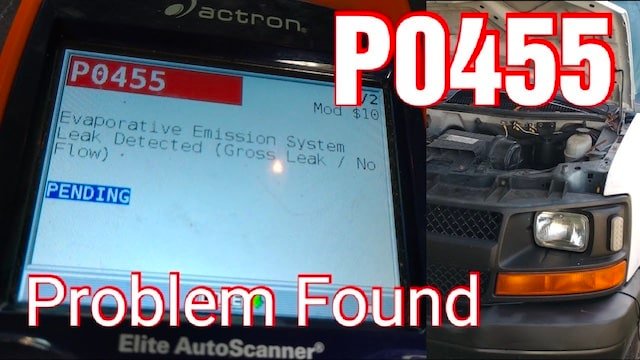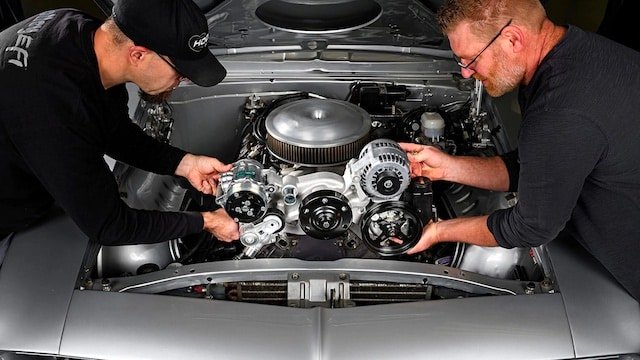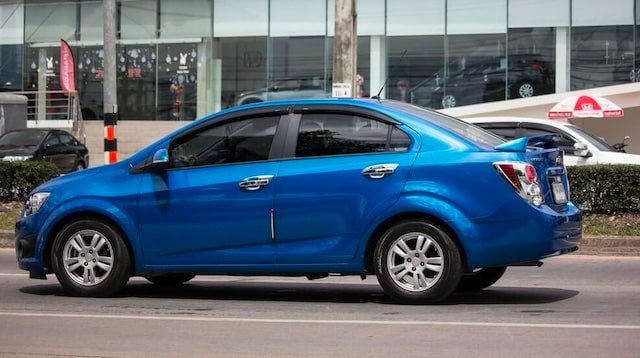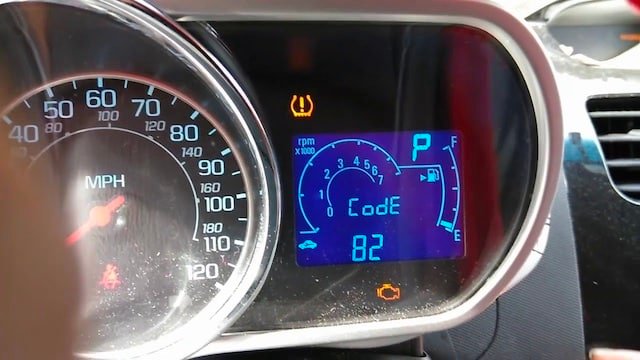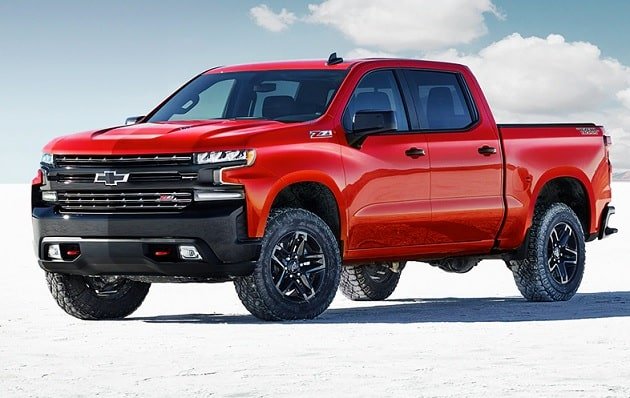Drivers switch rear-end gear ratio to improve gas mileage and overall power performance. Upgrading Chevy’s rear-end gear ratio is a very technical subject and it requires a grounded understanding of the compatibility chart.
We have gone through the trouble of breaking down this subject for you and will only provide information on some of the most requested rear-end gear switches.
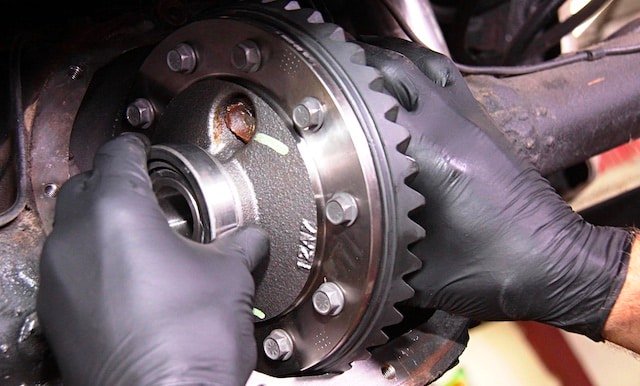
Chevy Rear End Gear Ratio Chart
To know your Chevy’s rear-end gear ratio, check the table using your RPO code. RPO code can be found on the driver-side door panel or glove box.
Alternatively, the GM rear end can be identified by the diameter of the ring gear (7.5 inches, 8.5 inches, or 10.5 inches). However, only experts are allowed to do this.
| RPO Code | Description | Ratio |
| G44 | Axle Rear | 3.07 |
| G72 | Axle Rear | 2.14 |
| G75 | Axle Rear | 3.62 |
| G76 | Positraction Rear | |
| G80 | Axle Positraction Limited Slip | |
| G81 | Positraction Rear Axle | |
| G82 | Axle Rear | 4.56 |
| G84 | Axle Rear | 4.10 |
| Axle, Rear, Limited Slip | ||
| G90 | Rear | 3.15 |
| G91 | Special Highway Rear Axle | 3.08 |
| G94 | Axle Rear | 3.31 |
| G96 | Axle Rear | 3.55 |
| G97 | Axle Rear | 2.73 |
| GH0 | Axle Rear | 3.54 |
| GH2 | Axle Rear | 2.29 |
| GH3 | Axle Rear | 2.77 |
| GH4 | Axle Rear | 2.92 |
| GH7 | Axle Rear | 2.73 |
| GJ1 | Axle Rear | 5.38 |
| GJ2 | Axle Rear | 5.13 |
| GK7 | Axle Rear | 4.78 |
| GK8 | Axle Rear | 4.33 |
| GK9 | Axle Rear | 4.63 |
| GL0 | Axle Rear | 5.13 |
| GL3 | Axle Rear | 6.17 |
| GM1 | Axle Rear | 2.59 |
| GM2 | Axle Rear | 3.44 |
| GM3 | Axle Rear | 3.45 |
| GM4 | Axle Rear | 3.67 |
| GM5 | Axle Rear | 3.89 |
| GM6 | Axle Rear | 4.22 |
| GM7 | Axle Rear | 3.68 |
| GM8 | Axle Rear | 2.56 |
| GM9 | Axle Rear | 4.11 |
| GS1 | Axle Rear | 2.73 |
| GS3 | Axle Rear | 3.73 |
| GS4 | Axle Rear | 3.70 |
| GS5 | Axle Rear | 4.11 |
| GS6 | Axle Rear | 4.56 |
| GS8 | Axle Rear | 3.94 |
| GT1 | Axle Rear | 2.56 |
| GT2 | Axle Rear | 2.29 |
| GT4 | Axle Rear (DUP of RPO Code 5X1) | 3.73 |
| GT5 | Axle Rear (DUP of RPO GT8) | 4.10 |
| GT7 | Axle Rear | 3.33 |
| GT8 | Axle Rear (DUP of RPO GT5) | 4.10 |
| GU1 | Axle Rear | 2.41 |
| GU2 | Axle Rear | 2.73 |
| GU3 | Axle Rear | 2.93 |
| GU4 | Axle Rear | 3.08 |
| GU5 | Axle Rear | 3.23 |
| GU6 | Axle Rear | 3.42 |
| GU7 | Axle Rear | 2.77 |
| GU8 | Axle Rear | 3.90 |
| GU9 | Axle Rear | 3.91 |
| GV0 | Axle Rear | 3.55 |
| GV1 | Axle Rear | 2.73 |
| GV2 | Axle Rear | 5.83 |
| GV3 | Axle Rear | 3.08 |
| GV4 | Axle Rear | 3.36 |
| GV5 | Axle Rear | 3.55 |
| GV7 | Axle Rear | 4.11 |
| GV8 | Axle Rear | 2.72 |
| GV9 | Axle Rear | 4.25 |
| GW2 | Axle Rear | 2.56 |
| GW3 | Axle Rear | 2.56 |
| GW4 | Axle Rear | 3.31 |
| GW5 | Axle Rear | 2.73 |
| GW6 | Axle Rear | 3.27 |
| GW8 | Axle Rear | 4.10 |
| GW9 | Axle Rear (DUP of RPO GU3) | 2.93 |
| GX1 | Axle Rear | 3.70 |
| GX2 | Axle Rear | 3.07 |
| GX4 | Axle Rear | 3.75 |
| GX5 | Axle Rear | 4.09 |
| GX6 | Axle Rear | 3.53 |
| GY2 | Axle Rear | 3.31 |
| GY4 | Axle Rear | 4.53 |
| GY9 | Axle Rear | 4.31 |
| H01 | Axle Rear | 3.07 |
| H04 | Axle Rear, SINGLE SPEED | 4.11 |
| H05 | Axle Rear | 3.73 |
| H12 | Axle Rear, 21000 LBS, EATON 21065S, SINGLE SPEED | |
| H42 | Axle Rear | 6.17 |
| H43 | Axle Rear | 5.43 |
| HA3 | Axle Rear, SINGLE SPEED | 5.29 |
| HC4 | Axle Rear | 4.56 |
| HC7 | Axle Rear, 7500 LBS, SINGLE SPEED | 5.13 |
| HC8 | Axle Rear, SINGLE SPEED, TRUCK | 3.21 |
| HC9 | Axle Rear | 5.13 |
| HE3 | Axle Rear, 3500 LBS, SINGLE SPEED | 3.07 |
| HE4 | Axle Rear | 3.40 |
| HF7 | Axle Rear, 10000 LBS, DANA 70, SINGLE | 4.56 |
| HF8 | Axle Rear | 4.88 |
| HJ1 | Axle Rear | 4.55 |
| HJ2 | Axle Rear | 5.86 |
| HJ3 | Axle Rear | 4.75 |
| HJ4 | Axle Rear | 6.50 |
| HJ5 | Axle Rear | 5.57 |
| HJ6 | Axle Rear | 4.78 |
| HJ7 | Axle Rear | 4.88 |
| HK1 | Axle Rear | 2.87 |
| HK3 | Axle Rear | 6.14 |
| HK9 | Axle Rear, 10000 LBS, SINGLE SPEED | 5.86 |
| HO4 | Axle Rear | 4.11 |
| HO6 | Axle Rear | 4.63 |
Now that you are familiar with your ring and pinion ratio, let’s do a breakdown of the implication for each switch:
- Chevy owners who wish to enjoy better gas mileage need to switch to a higher gear ratio while those who prioritize power or performance must switch to a lower ratio.
- In gear ratio calculation, high equals a lower number while low equals a higher number or figure. It is just the opposite of how we think.
- In other words, if you have a 4.10 ratio and want to enjoy better fuel mileage, you need to switch from a 4.10 ratio to a higher ratio of 3.42 or 3.73.
- If you want to improve towing power and you are on a 3.42 rear-end ratio, all you need to do is to switch to a lower ratio of 4.10.
- For Chevy with big tires, you may want to go to a lower ratio around 4.56 or 4.88.
Why Is Positraction Important?
If you are upgrading your Chevy for power, you need positraction for power to be equally distributed and improve traction. Without positraction, your car will find it difficult to navigate muddy or snowy roads because only one wheel has power.
Hence, when switching rear-end gear ratio for power and performance purposes, prioritize positraction too.
Are All GM 10 & 12 Bolts The Same?
GM 10 & 12 bolts pretty much have similar appearances and are interchangeable. Although, for one to work perfectly in place of the other, a bit of adjustment is usually needed.
This is because the pinion depth on a 10 bolt can be 5/8″ deeper than that of the 11 or 12 bolts. If you shorten the opinions on an 11 or 12-bolt gear and introduce shims, things should work perfectly but the shift may be sloppy.
On the other end, it is not advisable to use a 10 bolt in place of an 11 or 12 bolt.
What Is The Difference Between A 10 Bolt And 12-Bolt Rear End?
A bolt 10 is simply not as strong as a bolt 12 and that is the simplest way to answer this question. A 10 bolt cannot withstand a lot of torque or heavy hauling, hence is not great for off-road use. A 12 bolt, on the other hand, is built to handle heavy torque and off-road activities.
Chevy 10 Bolt Rear End Widths
There are only 4 basic ratios for a GM 10-bolt rear end – 2.73, 3.08, 3.42, and 3.73. Please note that the ring-and-pinion gears can be switched as long as the carrier has the right gear size.
- Rear ends with 3.08 gears usually come in 7.5/7.625 inch, 8.2 inch, and 8.6-inch units.
- Rear ends with 3.42 gears usually come in 8.2 and 8.6-inch units,
- Rear ends with 3.73 gears come in 8.5 8.6-inch units
Best Gear Ratio For Your GM 10 Bolt
The best gear ratio for a GM 10 bolt is 10,41 because it is the only ratio that allows your engine to turn 10,41 times per minute. The 10,41 gear ratio is also great for off-road activities and provides plenty of torque needed to travel at high speeds.
Conclusion
If your Chevy’s rear-end interchange is failing, it is very important to replace it. Rear-end interchanges are susceptible to failure and when this occurs, it brings the whole rear end with it.
When rear-end failures occur, suspension and tires are usually at risk, hence, you must consider only replacements best for your vehicle. Thanks to this guide, you now have a chart that can help you identify the best rear end for your car.
However, if you are still not confident about which one to choose, seek an expert online or visit a local repair shop.
